
- •Initializing with Constructor Functions . . . . .
- •Into a Web page as a separate section. Although JavaScript code can
- •Is that standard php script delimiters are guaranteed to be available
- •In the block. Any text or lines between the opening /* characters and
- •2.7541 Are not integers; they are floating-point numbers. A floating-
- •Value 300
- •Is a value of 2.5, because 6 goes into 15 exactly 2.5 times. But if you
- •IsEven.Php.
- •Ing example,
- •Ing curly brace is on its own line following the function statements.
- •In php 3 and earlier, it was necessary to put a function definition
- •Is called an iteration. When the conditional expression evaluates
- •Including Files
- •13. Close your Web browser window.
- •Including Files
- •In php, you can also use two operators to combine strings. The first
- •Xhtml source code gen-
- •Input. Php provides several functions for manipulating the case of a
- •Is uppercase. If you need the reverse of ucfirst(), the lcfirst()
- •In some situations, you will need to find and extract characters and
- •Information Interchange, or ascii, which are numeric represen-
- •In comparison, the following preg_match() function returns a value
- •In the pattern is optional. The following code demonstrates how to
- •Values; any strings you validate against a regular expression must
- •Value of 1 because the top-level domain contains a valid value of .Com.
- •Is submitted using the “post” method, the form data is embedded in
- •Validating String Data
- •Xhtml tags or character entities. The message field is a text string
- •Value of the header element. For example:
- •Xhtml code within a php script section.
- •Is typically the person who created the resource. Otherwise, the net-
- •If even a single character of the Web page is sent prior to sending
- •Variables to the file_put_contents() function.
- •Xhtml hyperlink. To download a file from outside the xhtml
- •If...Else statement to display the appropriate version of the mes-
- •Iterating Through an Array
- •Iterating Through an Array
- •In Chapter 2, you learned how to use a foreach statement to iterate
- •Iterating Through an Array
- •Iterating Through an Array
- •In comparison, the following code declares and initializes
- •If ((!file_exists("MessageBoard/messages.Txt"))
- •Values from the array to create a thumbnail gallery of images in which
- •Introduction to Databases
- •Including php, allow you to create Web pages that can read and write
- •Introduction to Databases
- •Information that can be organized into ordered sets of data, and
- •Information. Each recipe in a recipe database, for instance, is a single
- •Introduction to Databases
- •Index, which identifies records in a database to make retrievals and
- •In a single table. However, you might want to break the information
- •Into multiple tables to better organize it into logical sets. Another
- •Information in one of the tables confidential and accessible only by
- •Is the employee information table from Figure 7-1. The related table
- •Is a payroll table that contains confidential salary and compensation
- •Information. Notice that each table contains an identical number of
- •Introduction to Databases
- •Introduction to Databases
- •In a junction
- •Introduction to Databases
- •In a relational format is called a relational database management
- •Is a standard data manipulation language among many dbmSs.
- •Into the query area at the top of the screen or by dragging tables and
- •It is important to understand that even though many dbmSs sup-
- •Introduction to Databases
- •If you ever
- •Is. In comparison, the bigint data type stores integer values between
- •5 Rows in set (0.00 sec)
- •Int);[enter ]
- •Important, these two tabs can cause you to lose all of the data in the
- •Internet Explorer to export the table, click the Save button in the File
- •Ifies the table being changed and the change to make.
- •It easier for you to write php code that can be used with a variety of
- •Information about queries that match one of the following formats:
- •Various types of actions, depending on the type of query.
- •Include fields for the date and time of the flight, flight number, and
- •In the ChineseZodiac folder and upload the file to the server. Open
- •Including white space,
- •Information on a Web server. When you start a new session, the
- •Introduction to Object-Oriented Programming
- •Introduction to Object-Oriented
- •Variables associated with an object are called properties or attributes.
- •In the Loan object example, a function that calculates the number of
- •Introduction to Object-Oriented Programming
- •Introduction to Object-Oriented Programming
- •Include instances of objects inherit the object’s functionality.
- •In this chapter, you will create the Web site for an online order form
- •In an online store application. The application includes information
- •Ity of building a working online store. Online store classes are very
- •Information and products. The OnlineStore class requires that store
- •Information is stored in a table containing six fields: storeId, name,
- •Information. Instead, the class simply uses session iDs to keep track
- •Variable and function as necessary, without bothering with all this
- •In a class
- •Is developed. Imagine what would happen if Microsoft distributed
- •Ing class is invalid because it does not include an access specifier:
- •If they will not be supported by future xhtml versions or are not
- •Xhtml standards. To review the guide of current w3c css specifi-
- •Information to remind yourself or others of what the code is doing. A
- •Xhtml document to the external style sheet. This link informa-
- •If you select Apache from the WampServer menu and select Service
- •Ing code uses the number_format() function to add comma separa-
- •In data that a user submits to a php script.
- •Value of “On” and the display_startup_errors directive is assigned
- •Instead. By looking at the source code, you could see that the value of
- •Ing engine can even help locate logic errors.
- •In Chapter 8, along with the equivalent mssql_* functions, where
- •Inline styles, 632
- •Xhtml, 620–635 (continued)
Creating
PHP Code Blocks
PHP
supports two kinds of comments: line comments and block
comments.
A line comment automatically terminates at the end of
the
line in which it is inserted. To create a line comment, add either
two
forward slashes (//) or the pound symbol (#) before the text you
want
to use as a comment. (You do not need to include both.) The //
or
# characters instruct the scripting engine to ignore all text imme-
diately
following the characters to the end of the line. You can place a
line
comment either at the end of a line of code or on its own line.
Block
comments allow multiple lines of comment text to be added.
You
create a block comment by adding a forward slash and an asterisk
(/*)
before the start of the text that you want included in the block,
and
adding an asterisk and a forward slash (*/) after the last character
the
closing */ characters are ignored by the PHP engine. The following
code
shows a PHP code block containing line and block comments. If
a
client requests a Web page containing the following script in a Web
browser,
the scripting engine ignores the text marked with comments.
<?php
/*
This
line is part of the block comment.
This
line is also part of the block comment.
*/
echo
"<h1>Comments Example</h1>"; // Line comment
//
This line comment takes up an entire line.
#
This is another way of creating a line comment.
/*
This is another way of creating
a
block comment. */
?>
BlockIn the block. Any text or lines between the opening /* characters and
comments
cannot be
nested
inside other
block com-
ments. A block comment
stops at the first */,
regardless of how many
/* characters precede it.
Comments
created with
two slashes
(//) or the
/* and */
characters
are also used in C++,
Java, and JavaScript.
Comments created with
the pound symbol (#) are
used in Perl and shell
script programming.
21
To add comments to the PHP Environment Info Web page:
1.
Return to the MultipleScripts.php document in your text
editor.
Add the following block comment immediately after the first
opening PHP script delimiter:
/*
PHP code for Chapter 1.
The purpose of this code is to demonstrate how to
add multiple PHP code blocks to a Web page.
*/
2.
3.
Next, add the following line comments immediately after the
block comment, taking care to replace your name with your
first and last name and today’s date with the current date:
// your name
# today's date
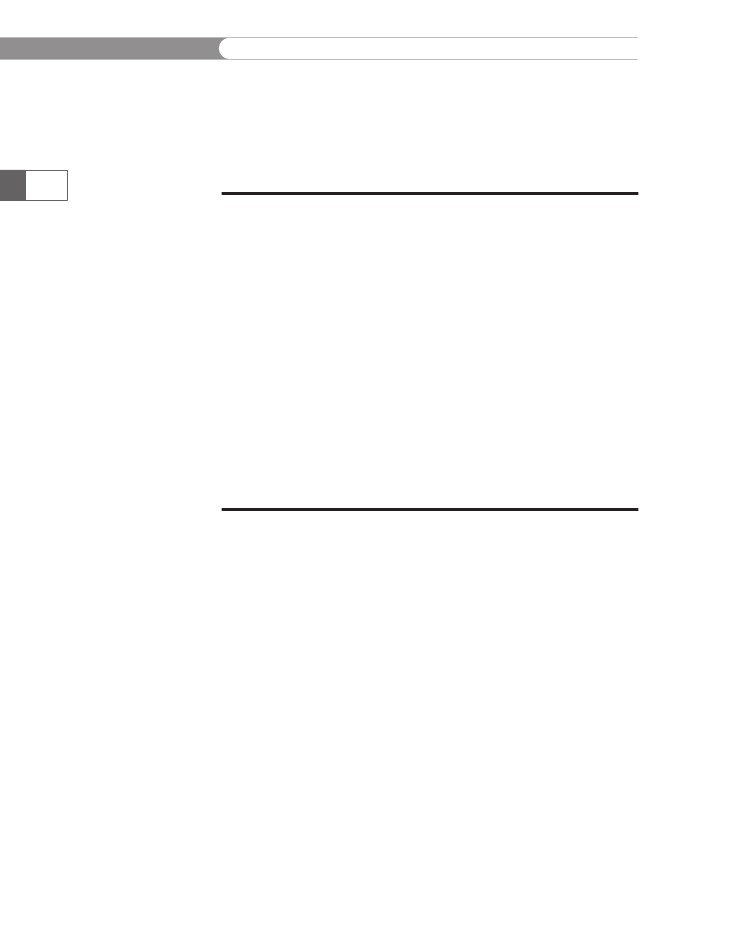
CHAPTER
1
Getting
Started with PHP
4.
Save
the MultipleScripts.php document, upload it to the Web
server,
and validate the document with the W3C XHTML
Validator.
Open the document from your Web server to
ensure
that the comments are not displayed.
Close
your Web browser window.
5.
22
Short
Quiz
1.
How
many code declaration blocks can be inserted in a PHP
document?
Why
does the PHP Group recommend that you use standard
PHP
script delimiters to write PHP code declaration blocks?
What
character or characters are used as delimiters to sepa-
rate
multiple arguments (parameters) in a function declara-
tion
or function call?
Describe
the type of information that the phpinfo()
function
generates.
Identify
the two types of comments available in PHP and indi-
cate
when each would be used.
2.
3.
4.
5.
Using
Variables and Constants
One
of the most important aspects of programming is the ability to
store
values in computer memory and to manipulate those values.
These
stored values are called variables. The values, or data, con-
tained
in variables are classified into categories known as data types.
In
this section, you will learn about PHP variables and data types, and
the
operations that can be performed on them.
The
values a program stores in computer memory are commonly
called
variables. Technically speaking, though, a variable is actually a
specific
location in the computer’s memory. Data stored in a specific
variable
often changes. You can think of a variable as similar to a stor-
age
locker—a program can put any value into it, and then retrieve the
value
later for use in calculations. To use a variable in a program, you
first
have to write a statement that creates the variable and assigns it a
name.
For example, you can have a program that creates a variable to
store
the current time. Each time the program runs, the current time
is
different, so the value varies.
Using
Variables and Constants
Programmers
often talk about “assigning a value to a variable,” which
is
the same as storing a value in a variable. For example, a shopping
cart
program might include variables that store the current cus-
tomer’s
name and purchase total. Each variable will contain different
values
at different times, depending on the name of the customer and
the
items the customer is purchasing.
23
Naming
Variables
The
name you assign to a variable is called an identifier. You must
observe
the following rules and conventions when naming a variable:
•
Identifiers
must begin with a dollar sign (
• Identifiers may contain uppercase and lowercase letters, numbers,
or underscores (_). The first character after the dollar sign must be
a letter.
• Identifiers cannot contain spaces.
• Identifiers are case sensitive.
One common practice is to use an underscore character to separate indi-
vidual words within a variable name, as in $my_variable_name.
Another option is to use initial capital letters for each word in a variable
name, as in $MyVariableName.
Unlike other types of PHP code, variable names are case sensitive.
Therefore, the variable named $MyVariable is completely different
from one named $Myvariable, $myVariable, or $MYVARIABLE. If
you receive an error when running a script, be sure that you are using
the correct case when referring to any variables in your code.
Declaring and Initializing Variables
Before you can use a variable in your code, you have to create it. The
process of specifying and creating a variable name is called declar-
ing the variable. The process of assigning a first value to a variable is
called initializing the variable. Some programming languages allow
you to first declare a variable without initializing it. However, in PHP,
you must declare and initialize a variable in the same statement, using
the following syntax:
$variable_name = value;
The equal sign in the preceding statement assigns an initial value to
(or initializes) the variable you created (or declared) with the name
$variable_name.
If you
attempt to
declare a
variable
without
initializing it,
you will receive an error.
CHAPTER
1
Getting
Started with PHP
The
value you assign to a variable can be a literal string, a numeric
value,
or a Boolean value. For example, the following statement
assigns
the literal string “Don” to the variable $MyName:
$MyName
= "Don";
24
When
you assign a literal string value to a variable, you must enclose
the
text in single or double quotation marks, as shown in the preced-
ing
statement. However, when you assign a numeric or Boolean value
to
a variable, do not enclose the value in quotation marks or PHP will
treat
the value as a string instead of a number. The following state-
ment
assigns the numeric value 59 to the variable $RetirementAge:
$RetirementAge
= 59;
In
addition to assigning literal strings, numeric values, and Boolean
values
to a variable, you can assign the value of one variable to
another.
For instance, in the following code, the first statement
declares
a variable named $SalesTotal
and
assigns it an initial value
of
0. (Remember that in PHP you must initialize a variable when
you
first declare it.) The second statement creates another variable
named
$CurOrder
and
assigns it a numeric value of 40. The third
statement
then assigns the value of the $CurOrder
variable
(40) to the
$SalesTotal
variable.
$SalesTotal
= 0;
$CurOrder
= 40;
$SalesTotal
= $CurOrder;
Displaying
Variables
To
display a variable with the echo
statement,
you simply pass the
variable
name to the echo
statement,
but without enclosing it in quo-
tation
marks, as follows:
$VotingAge
= 18;
echo
$VotingAge;
If
you want to display text strings and variables in the same
statement,
you
can pass them to the echo
statement
as individual arguments,
separated
by commas. For example, the following code displays the
text
shown in Figure 1-11. Notice that the text and elements are con-
tained
within quotation marks, but the $VotingAge
variable
is not.
echo
"<p>The legal voting age is ", $VotingAge, ".</p>";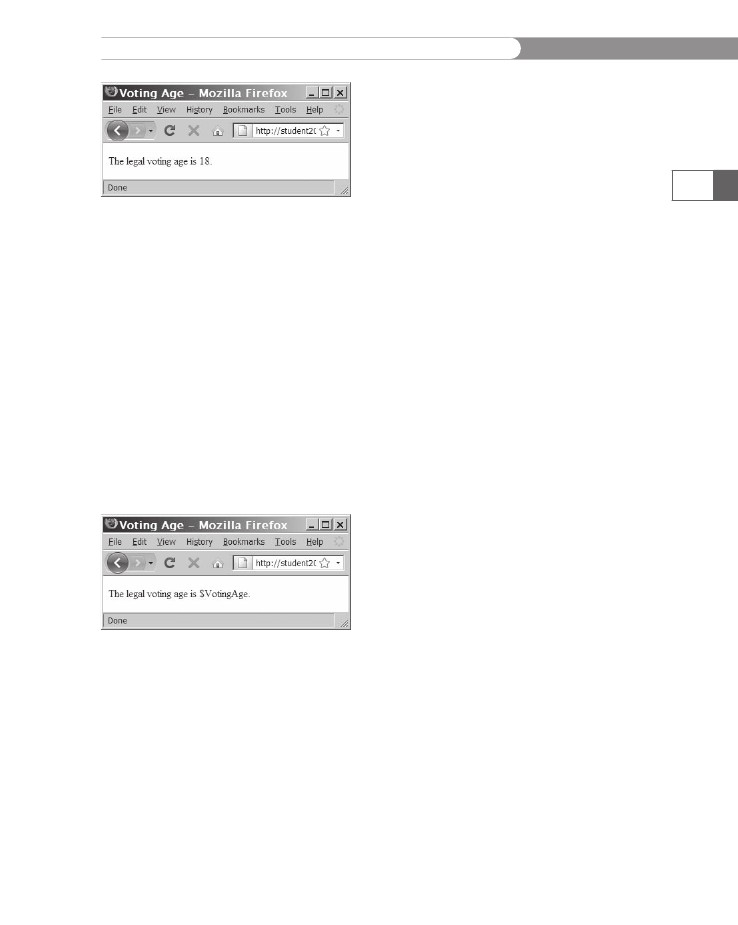
Using
Variables and Constants
25
Figure
1-11 Output from an echo
statement
that
is passed text and a variable
You
can also include variable names inside a text string, although the
results
you see on the screen depend on whether you use double or
single
quotation marks around the text string that includes the vari-
able
name. If you use double quotation marks, the value assigned to
the
variable will appear. For example, the following statement displays
the
same output that is shown in Figure 1-11:
echo
"<p>The legal voting age is $VotingAge.</p>";
By
contrast, if you use a variable name in a text string enclosed by
single
quotation marks, the name of the variable will appear. For
example,
the following statement displays the output shown in
Figure
1-12:
echo
'<p>The legal voting age is $VotingAge.</p>';
Figure
1-12 Output of an echo
statement
that
includes
text and a variable surrounded by single
quotation
marks
Modifying
Variables
You
can modify the variable’s value at any point in a script. The fol-
lowing
code declares a variable named $SalesTotal,
assigns
it an
initial
value of 40, and displays it using an echo
statement.
The third
statement
changes the value of the $SalesTotal
variable
and the
fourth
statement displays the new value. Figure 1-13 shows the out-
put
in a Web browser.
CHAPTER
1
The
two
adjacent
dollar signs
are not
special
syntax. The
first dollar sign, because
it is not immediately
followed by a variable
name, is treated as a
literal dollar sign charac-
ter and displayed on the
page. The second dollar
sign and the variable
name that follows it are
treated as an identifier,
and the value of the
identifier is displayed
on the page.
Getting Started with PHP
$SalesTotal =
echo "<p>Your
$SalesTotal =
echo "<p>Your
40;
sales total is $$SalesTotal</p>";
50;
new sales total is $$SalesTotal</p>";
26
Figure 1-13
Results of a script that includes a changing variable
It’s an old tradition among programmers to practice a new language
by writing a script that prints or displays the text “Hello World!”. If
you are an experienced programmer, you have undoubtedly created
“Hello World” programs in the past. If you are new to programming,
you will probably create “Hello World” programs as you learn pro-
gramming languages. Next, you will create your own “Hello World”
program in PHP. You will create a simple script that displays the text
“Hello World!”, says “Hello” to the sun and the moon, and displays a
line of scientific information about each celestial body. You will use
variables to store and display each piece of information.
To create the “Hello World” program:
1.
2.
Create a new document in your text editor.
Type the <!DOCTYPE> declaration, <html> element, header
information, and <body> element. Use the strict DTD and
“Hello World” as the content of the
<title> element. Yourdocument should appear as follows:
<!DOCTYPE html PUBLIC "-//W3C//DTD XHTML 1.0
Strict//EN"
"http://www.w3.org/TR/xhtml1/DTD/xhtml1-strict.dtd">
<html>
<head>
<title>Hello World</title>
</head>
<body>
</body>
</html>
3.
Add the following standard PHP script delimiters to the docu-
ment body:
<?php
?>
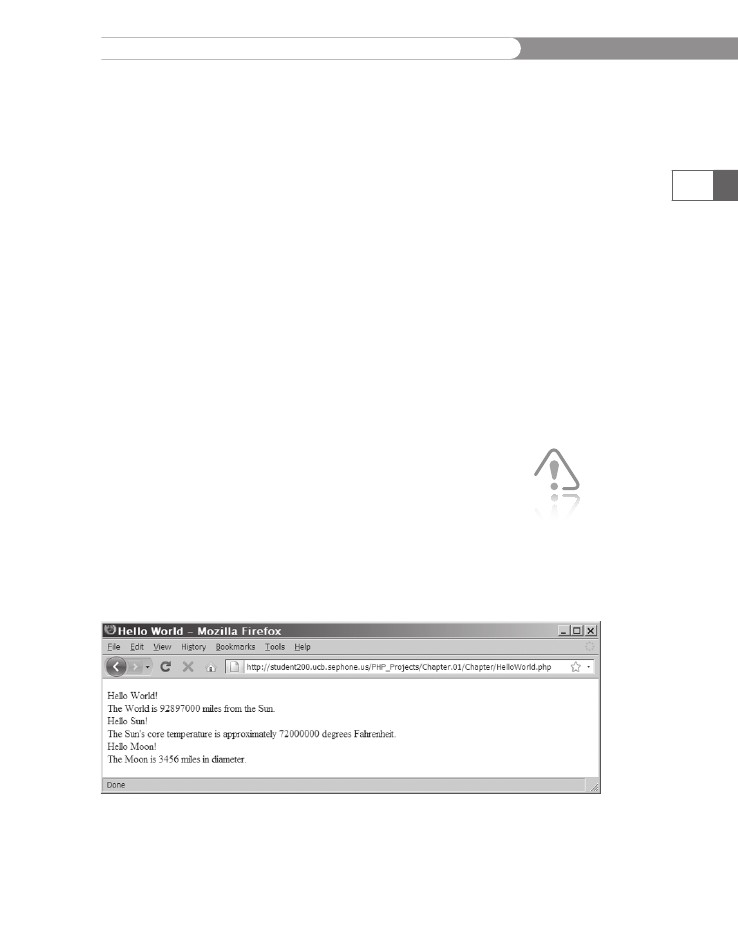
Using
Variables and Constants
4.
In
the code block, type the following statements to declare the
variables
containing the names of each celestial body, along
with
variables containing scientific information about each
celestial
body:
$WorldVar
= "World";
$SunVar
= "Sun";
$MoonVar
= "Moon";
$WorldInfo
= 92897000;
$SunInfo
= 72000000;
$MoonInfo
= 3456;
27
5.
Add
the following statements to the end of the script sec-
tion
to display the values stored in each of the variables you
declared
and initialized in the last step:
echo
"<p>Hello $WorldVar!<br />";
echo
"The $WorldVar is $WorldInfo miles from the
$SunVar.<br
/>";
echo "Hello ", $SunVar, "!<br />";
echo "The $SunVar's core temperature is
approximately $SunInfo
degrees Fahrenheit.<br />";
echo "Hello ", $MoonVar, "!<br />";
echo "The $MoonVar is $MoonInfo miles in
diameter.</p>";
6.
Save the document as HelloWorld.php in the Chapter direc-
tory for Chapter 1. After you save and upload the document,
validate it with the W3C XHTML Validator.
Open the HelloWorld.php file in your Web browser by enter-
ing the following URL: http://<yourserver>/PHP_Projects/
Chapter.01/Chapter/HelloWorld.php. You should see the
Web page in Figure 1-14.
7.
If you
receive error
messages,
make sure
that you
typed all the
variables in the correct
case. (Remember that
variables in PHP are case
sensitive.)
Figure 1-14
8.
Output of HelloWorld.php
Close your Web browser window.
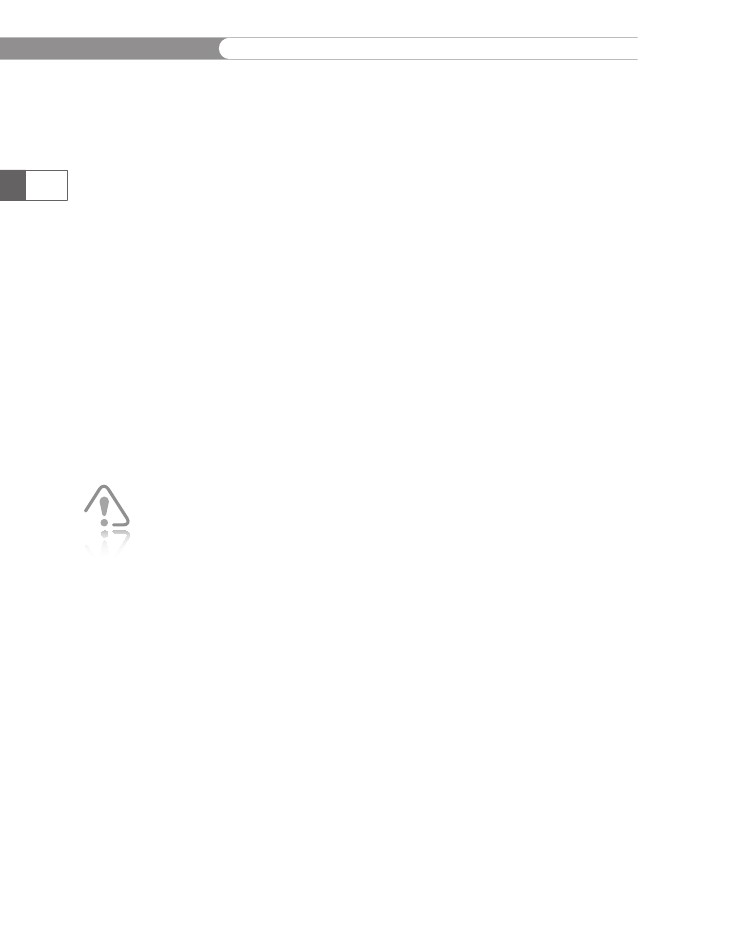
CHAPTER
1
Getting
Started with PHP
Defining
Constants
A
constant contains information that does not change during the
course
of program execution. You can think of a constant as a vari-
able
with a static value. A common example of a constant is the value
of
pi (π), which represents the ratio of the circumference of a circle
to
its
diameter. The value of pi never changes from a constant value of
approximately
3.141592.
Unlike
variable names, constant names do not begin with a dollar
sign
($).
In addition, it is common practice to use all uppercase letters
for
constant names. When you create a constant, you do not declare
and
initialize it the way you declare a variable. Instead, you use the
define()
function
to create a constant. The syntax for the define()
function
is as follows:
define("CONSTANT_NAME",
value);
28
The
value you pass to the define()
function
can be a text string, num-
ber,
or Boolean value. In the following example, the first constant def-
inition
passes a text string to the define()
function
while the second
constant
definition passes a number:
define("DEFAULT_LANGUAGE",
"Navajo");
define("VOTING_AGE",
18);
Remember
that you
cannot
change the
value of a
constant
after you define it in your
program. If you attempt
to use the define()
function to change the
value of an existing
constant, you will receive
an error.
By default, constant names are case sensitive, as are variables.
However, you can make constant names case insensitive by passing a
Boolean value of TRUE as a third argument to the define() function, as
follows:
define("DEFAULT_LANGUAGE", "Navajo", TRUE);
With the preceding statement, you can refer to the
DEFAULT_LANGUAGE constant using any letter case, including
default_language or Default_Language. However, standard
programming convention is to use all uppercase letters for con-
stant names, so you should avoid making your constant names case
insensitive.
When you refer to a constant in code, remember not to include a dol-
lar sign, as you would with variable names. You can pass a constant
name to the echo statement in the same manner as you pass a vari-
able name (but without the dollar sign), as follows:
echo "<p>The legal voting age is ", VOTING_AGE, ".</p>";
The preceding statement displays the text “The legal voting age is 18.”
in the Web browser. Unlike variables, you cannot include the constant
name within the quotation marks that surround a text string. If you
do, PHP treats the constant name as ordinary text that is part of the

Using
Variables and Constants
string.
For example, consider the following statement, which includes
the
constant name within the quotation marks that surround the text
string:
echo
"<p>The legal voting age is VOTING_AGE.</p>";
Instead
of displaying the value of the constant (18), the preceding
statement
displays “The legal voting age is VOTING_AGE.” in the
Web
browser.
To
replace the $WorldInfo,
$SunInfo, and
$MoonInfo
variables
in
the
HelloWorld.php script with constants:
1.
2.
PHP
includes
numerous
predefined
constants
that
you
can use in
your
scripts.
29
Return
to the HelloWorld.php document in your text editor.
Replace
the $WorldInfo,
$SunInfo, and
$MoonInfo
variable
declarations
with the following constant definitions:
define("WORLD_INFO",
92897000);
define("SUN_INFO",
72000000);
define("MOON_INFO",
3456);
3.
Replace
the $WorldInfo,
$SunInfo, and
$MoonInfo
variable
references
in the echo
statements
with the new constants. The
modified
echo
statements
should appear as follows:
echo
"<p>Hello ", $WorldVar, "!<br />";
echo
"The $WorldVar is ", WORLD_INFO,
"
miles from the $SunVar.<br />";
echo "Hello ", $SunVar, "!<br />";
echo "The $SunVar's core temperature is
approximately ",
SUN_INFO, " degrees Fahrenheit.<br />";
echo "Hello ", $MoonVar, "!<br />";
echo "The $MoonVar is ", MOON_INFO, " miles in
diameter.</p>";
4.
Save and upload the HelloWorld.php document and then vali-
date it with the W3C XHTML Validator.
Open the HelloWorld.php document from your Web server.
The Web page should look the same as it did before you
added the constant declarations.
Close your Web browser window.
5.
6.
Short Quiz
1.
Describe the two-step process of making a variable available
for use in the PHP script.
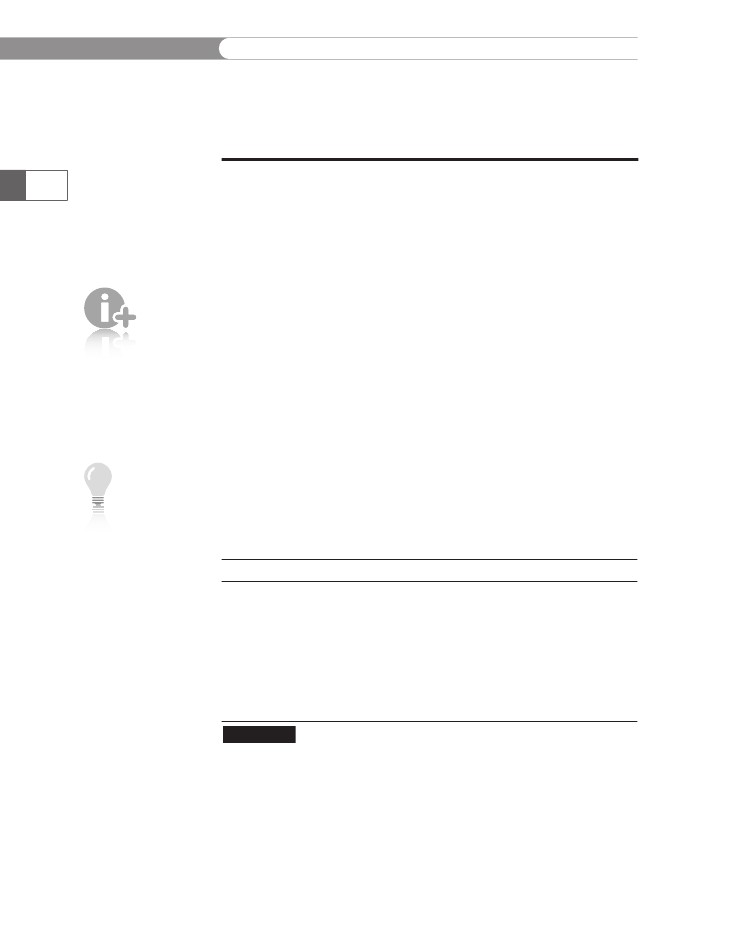
CHAPTER
1
Getting
Started with PHP
2.
Explain
the syntax for displaying a variable or variables in the
PHP
script using the echo
or
print
statements.
How
do you make a constant name case insensitive?
3.
30
Working
with Data Types
PHP
also
supports a
“resource”
data type,
which is a
special vari-
able that holds a refer-
ence to an external
resource, such as a data-
base or XML file.
The term
NULL refers
to a data type
as well as a
value that can
be assigned to a variable.
Assigning the value NULL
to a variable indicates
that the variable does not
contain a usable value. A
variable with a value of
NULL has a value
assigned to it—null is
really the value “no
value.” You assign the
NULL value to a variable
when you want to ensure
that the variable does not
contain any data. For
instance, with the
$SalesTotal variable
you saw earlier, you may
want to ensure that the
variable does not contain
any data before you use
it to create another pur-
chase order.
Variables can contain many different kinds of values—for example,
the time of day, a dollar amount, or a person’s name. A data type
is the specific category of information that a variable contains. The
concept of data types is often difficult for beginning programmers to
grasp because in real life you don’t often distinguish among different
types of information. If someone asks you for your name, your age, or
the current time, you don’t usually stop to consider that your name
is a text string and that your age and the current time are numbers.
However, a variable’s specific data type is very important in program-
ming because the data type helps determine the manner in which the
value is stored and how much memory the computer allocates for the
data stored in the variable. The data type also governs the kinds of
operations that can be performed on a variable.
Data types that can be assigned only a single value are called primi-
tive types. PHP supports the five primitive data types described in
Table 1-1.
Data Type
Integer numbers
Floating-point
numbers
Boolean
String
NULL
Table 1-1
Description
The set of all positive and negative numbers and
zero, with no decimal places
Positive or negative numbers with decimal places or
numbers written using exponential notation
A logical value of “true” or “false”
Text such as “Hello World”
An empty value, also referred to as a NULL value
Primitive PHP data types
The PHP language also supports reference, or composite, data types,
which can contain multiple values or complex types of information,
as opposed to the single values stored in primitive data types. The two
reference data types supported by the PHP language are arrays and
objects. In this chapter, you will study basic array techniques. You will
learn about advanced arrays and objects in later chapters.

Working
with Data Types
Many
programming languages require that you declare the type of
data
that a variable contains. Such programming languages are called
strongly
typed programming languages. Strong typing is also
known
as static typing because the data type for a variable will not
change
after it has been declared. Programming languages that do not
require
you to declare the data types of variables are called loosely
typed
programming languages. Loose typing is also known as
dynamic
typing because the data type for a variable can change after
it
has been declared. PHP is a loosely typed programming language.
In
PHP, you are not required to declare the data type of variables,
and,
in fact, you are not allowed to do so. Instead, the PHP scripting
engine
automatically determines what type of data is stored in a vari-
able
and assigns the variable’s data type accordingly. The following
code
demonstrates how a variable’s data type changes automatically
each
time the variable is assigned a new literal value.
$ChangingVariable
= "Hello World"; // String
$ChangingVariable
= 8;// Integer number
$ChangingVariable
= 5.367;// Floating-point
//
number
$ChangingVariable = TRUE;// Boolean
$ChangingVariable = NULL;// NULL
31
Although you
cannot
declare a data
type when you
first create a
variable, you can force a
variable to be converted
to a specific type. You
learn how to force a vari-
able to be a specific type
at the end of this section.
Strictly
speaking,
there are dif-
ferences
between the
terms “strong typing” and
“static typing,” and
between “loose typing”
and “dynamic typing.”
The specifics of these
differences are beyond
the scope of this book.
The terms “strongly
typed” and “loosely
typed” are used here in
the generic sense, not in
the technical sense.
The next two sections focus on two commonly used data types:
numeric and Boolean.
Numeric Data Types
